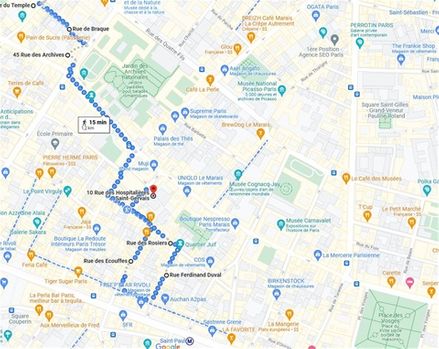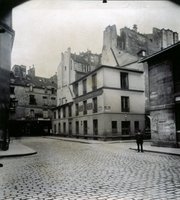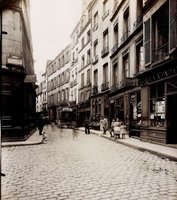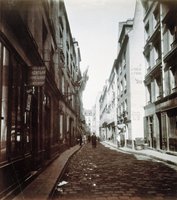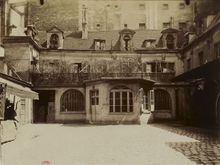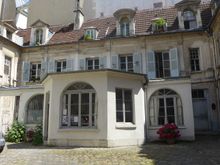Hora fugit - Un peu de Paris
Rue des Rosiers neighborhood
The stroll in the Temple district begins with the Carreau du Temple, where, from 1880 onwards, many foreign Jews from Central and Eastern Europe settled. They were fleeing misery and, above all, persecution. Many Ashkenazi Jews who settled there worked in the clothing trade. Others settled around the rue des Rosiers and the Ecouffes, where they could find cheap rents and a Jewish presence in the Marais from the 12th century. After a long period of absence from 1394, when a Royal decree expelled them from the France, the Jews were back after the Revolution.
These hard-working and entrenched lives in this small neighborhood were to be decimated by the Holocaust, from which few escaped.
We can pursue the previous stroll and reach the rue des Rosiers via the rue des Francs-Bourgeois and the rue Vieille du Temple.
The stroll is centred around rue des Rosiers, rue des Hospitalières-Saint-Gervais, rue des Ecouffes and rue Ferdinand-Duval.
Rue des Rosiers
The rue des Rosiers is still today the main street of the Jewish district. However, the street has been changing a lot over the last twenty years. Today it is a pedestrian street where few traditional Jewish shops can be found amid trendy shops and high-priced clothing stores.
Atget was using the Marquis de Rochegude ‘s Paris guide, which was describing rue des Rosiers in those times as following:
“Nowadays, nearly only Jews are living there as shown by many Jewish signboards, Hebrew writing in shop windows, Jewish butcher's shops, unleavened bread shops, etc. It is better to go there on Saturdays: you will hear many foreign languages and you will see Semitic faces. It is the Parisian ghetto.”
Rue des Rosiers - Rue des Hospitalières Saint Gervais
To the rather cold description by the Marquis, I would add the poignant lines of the Apollinaire's poem Zone, full of humankind:
And now you are crying at the sight of refugees
Who believe in God who pray whose women nurse babies
The hall of the train station is filled with the refugee-smell
Like the Magi refugees believe in their star
They expect to find silver mines in the Argentine
And to return like kings to their abandoned countries
One family carries a red eiderdown you carry your heart
Eiderdown and dreams are equally fantastic
Some of the refugees stay on in Paris settling
Into slums on the rue des Rosiers or the rue des Ecouffes
I have seen them often at dusk they breathe at their doorways
They budge from home as reluctantly as chessmen
They are chiefly Jewish the women wear wigs
And haunt backrooms of little shops in little chairs
Rue des Hospitalières-Saint-Gervais, marché des Blancs Manteaux (on the right) and rue des Rosiers (at the back).
1910 - Atget
(Musée Carnavalet)
Before World War II, when most of the Jewish population was deported and exterminated, the center of the neighborhood was nicknamed the "pletzl", from the Yiddish word "little square". This little place was located by Léon-Paul Fargue at the corner of the rue des Rosiers and rue des Ecouffes. Others locate it around the Saint-Paul metro station or at the angle of rue des Hospitalières-Saint-Gervais.
It requires a great deal of imagination, whether it be today, or when looking at Atget's photo, to hear the sounds of the past, like a fiddle playing tunes of a melody, or the Yiddish accents of distant Slav countries. It is as if the asphalt had definitely covered them up together with the cobbles. Is this lack of sound not finally more dignified when one reads this plate on the school of Hospitalières-Saint-Gervais commemorating the 165 children deported to Auschwitz? Another plate commemorates the courageous engagement of its director, Joseph Migneret, who saved many Jewish children at the risk of his life. His name is engraved on the Monument of the Allée des Justes that can be seen near the rue du Grenier-sur-l'Eau. The pretty square in rue des Rosiers also bears his name (Philippe Auguste enclosure).
Rue des Rosiers
In his book the Parisian pedestrian, published in 1939, the writer Leon-Paul Fargue described the district, saying that it was not a ghetto like in Poland or Romania; it was rather like a small country bordered by the streets: rue du Roi-de-Sicile, rue Ferdinand-Duval, rue Vieille du Temple; its center was at the angle of rue des Ecouffes and rue des Rosiers, with the Speiser bookstore at 34 rue des Rosiers. Wolf Speiser, born in Odessa in 1869, published around 1910 an almanac for newcomers, providing advice and transliteration of street and station names in Hebrew characters and their translation into Yiddish. Thus, for example, the Gare Saint-Lazare was mentioned in Yiddish, "vogsal san lasar", then in French transliteration, "gar san lazar".
The wine merchant, La Vendangeuse, was located next door at 32, rue des Rosiers. Today the two shops are united under the same name, famous for its fallafels. Ashkenazim and Sephardim live side by side perpetuating a Jewish presence long rooted in the Marais.
Wine shop « La Vendangeuse »
Rue des Rosiers - corner rue des Ecouffes
1910 Atget
(Musée Carnavalet)
Rue des Ecouffes
It seems there was a sign board representing a popular poem written in the 13rd century by Jean Renart, l'Escoufle( “The Kite”) which gave this name to the street. The kite is a bird of prey, a name that is also commonly given to the pawnbrokers who lived in the street...
Rue des Ecouffes
(rue des Rosiers at the back)
Atget
(Musée Carnavalet)
At the end of rue des Ecouffes, turn left into rue du Roi de Sicile, then left into rue Ferdinand-Duval.
Rue Ferdinand-Duval
It used to be rue des Juifs already under Louis XII, but due to the Dreyfus affair and the resulting wave of antisemitism, its name was replaced in 1900 by the name of the prefect of the Seine, Ferdinand Duval (1826-1896). Very few traditional shops have survived, a bazaar selling candlesticks and religious articles seems to have resisted, but the increasing presence of fashion shops is evident as in the Rue des Rosiers.
The Hôtel de Cormery, at 20 rue Ferdinand-Duval was once known as the Hôtel des Juifs. At the end of the 14th century, it belonged to Manessier de Vesoul, public counsel for the community of Jews in Northern France.
"Hôtel des Juifs"
20 rue Ferdinand-Duval
1910 Atget
(Musée Carnavalet)
At the end of the street, turn right onto rue des Rosiers.
Angle rues des Rosiers et Ferdinand-Duval
Atget
(Musée Carnavalet)
To continue with the stroll Place des Vosges, at the end of rue des Rosiers, turn left onto rue Pavée, then right onto rue des Francs-Bourgeois.
Texte / Photos : Martine Combes
Contact / newsletter:
